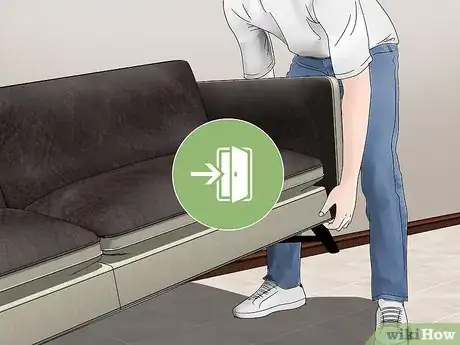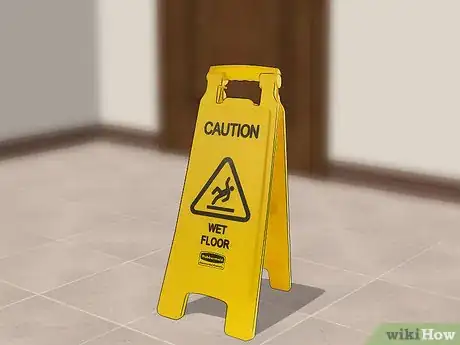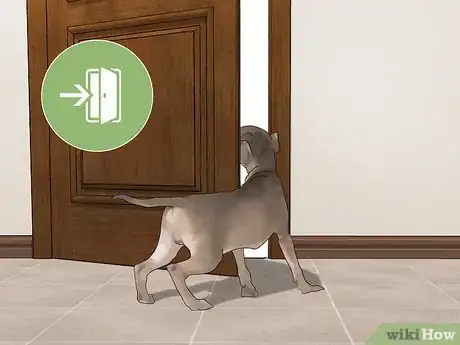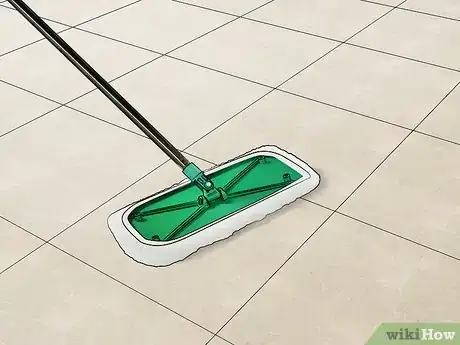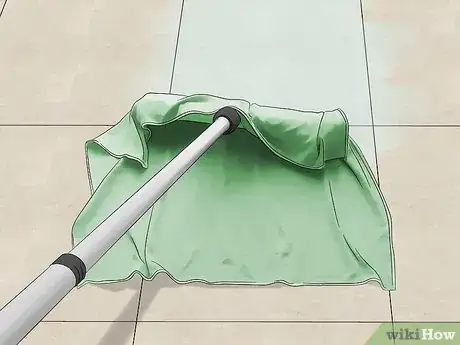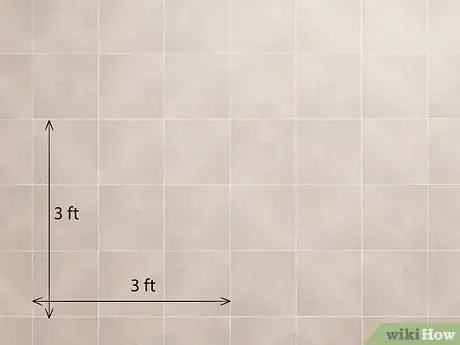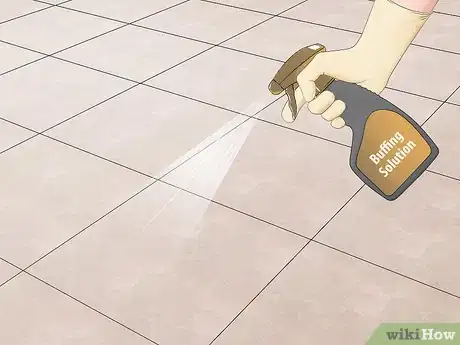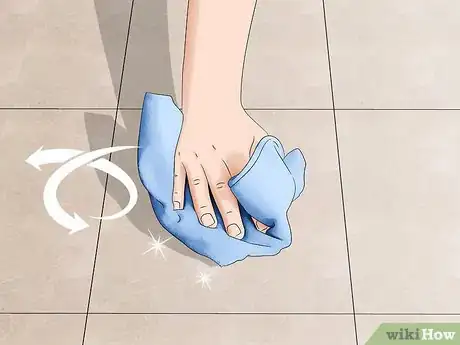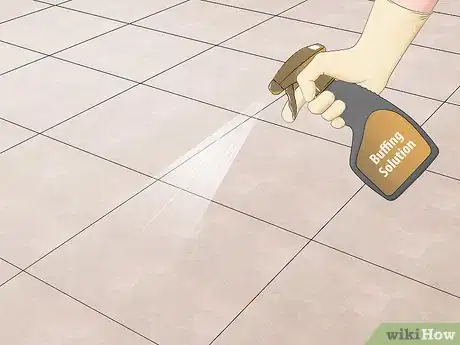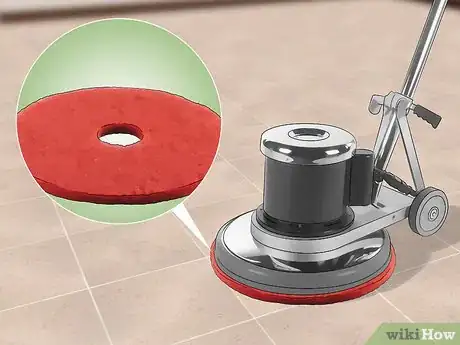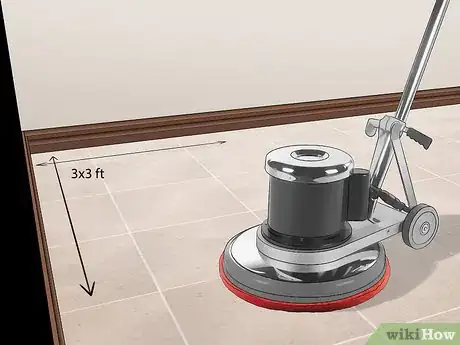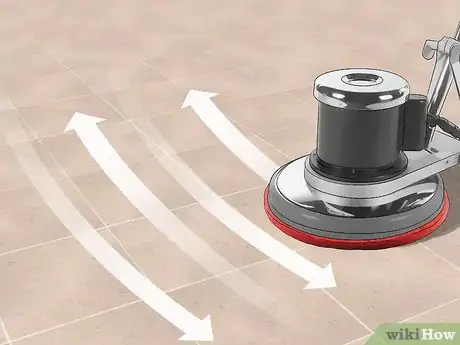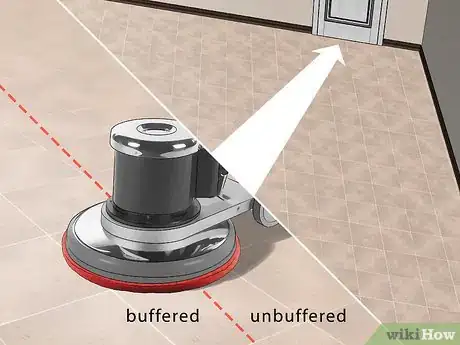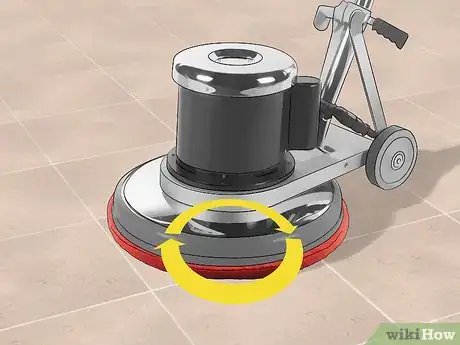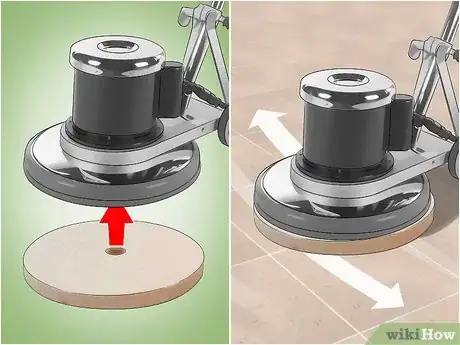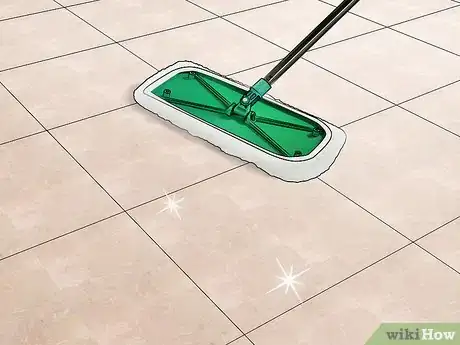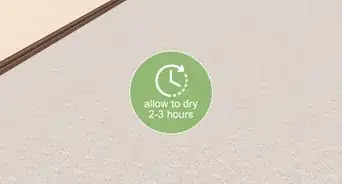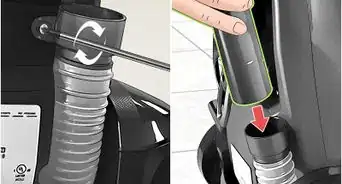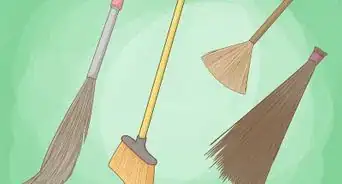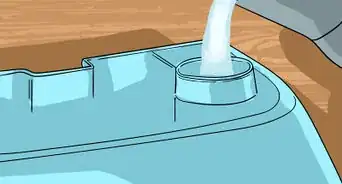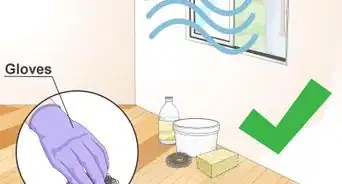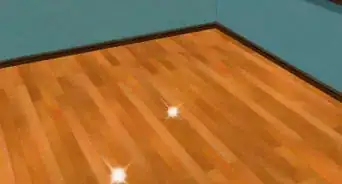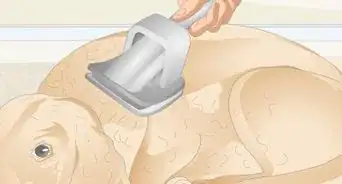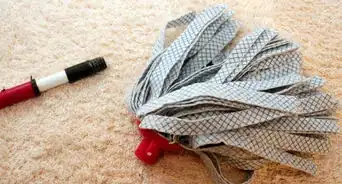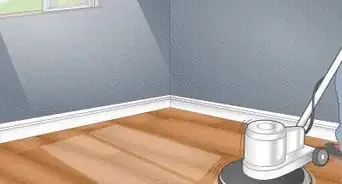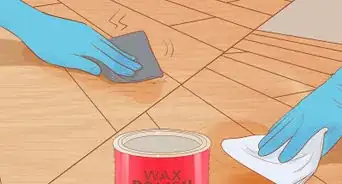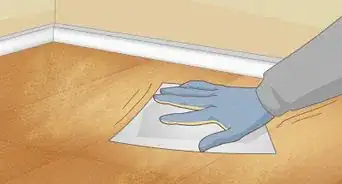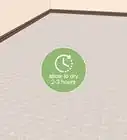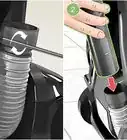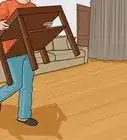This article was co-authored by Michelle Driscoll, MPH and by wikiHow staff writer, Danielle Blinka, MA, MPA. Michelle Driscoll is the Owner of Mulberry Maids, which is based in Fort Collins, Colorado. With five years of experience, her business specializes in cleaning homes and small offices. She holds a Masters in Public Health from the Colorado School of Public Health. Additionally, Mulberry Maids has an A+ rating from the Better Business Bureau.
There are 8 references cited in this article, which can be found at the bottom of the page.
This article has been viewed 108,686 times.
If you have scratched or scuffed floors, buffing them can refresh their shine. You can improve the look of your floors by buffing them by hand, but it's best to buy or rent a floor buffer, which uses slow speeds and high pressure to remove and replace the top layer of finish on your flooring. You can buff any type of floor, whether it’s wood, vinyl, concrete, or tile. Before you buff your floor, make sure you secure the area and clean the floor to remove any grime. Then, use a microfiber cloth or a spray buffing machine to restore your floor's shine.
Steps
Securing the Area
-
1Remove movable items from the floor being buffed. Place these items in a separate room or hallway. Moving these items allows you to buff the area under and around them. Otherwise, it will be very difficult for you to get an even shine.
- Keep in mind that a buffer is a bulky machine that can easily damage items that it bumps into, and it'll be harder for you to buff the area around the items in the room if you don’t remove them.
-
2Block off the area to prevent people from slipping on the wet floor. This will also help protect your freshly buffed floor from getting dirty while you’re still working. Tell other people living in your home or those who are in your place of business that the floor will be wet for the next several hours.[1]
- If you moved large items from the room, you can always use these as a blockade to help keep people out. Simply position them along the entrance to the room.
- If you’re cleaning a commercial floor, put up “Caution” or “Wet Floor” signs for added safety.
Advertisement -
3Place your pets in a safe location if you’re buffing the floor of a home. Pets can get in the way of the buffer and may dirty your floor. You don’t want to accidentally buff pet fur into your floor, as you won’t be able to remove it once it’s buffed into the finish. Put your pets in a separate room and shut the door.
- Alternatively, you can place your pets in their kennel if they already use one.
- Your pets will likely be afraid of the buffer, so keeping them out of the way will save them a lot of stress!
Cleaning the Floor
-
1Use a broom or dust mop to remove any debris. Start in the corner of the room and slowly sweep the entire room. Make sure you get the floor as clean as possible. Otherwise, you risk buffing dirt into the finish.[2]
- Over time, buffing a dirty floor can permanently alter the color of your floor finish, turning it a dingy yellow color.
- You can also use a vacuum to suck up the dirt you swept. Use a vacuum attachment meant for your type of flooring.
-
2Wash the floor with a wet mop to ensure it’s completely clean. For best results, dip the mop into a bucket of soapy warm water. Then, start in the corner of the room and slowly work your way back toward the entrance. As you mop, make short, even strokes to clean the floor.[3]
- Rinse your mop when it starts to look dirty.
- Use a floor cleaner that’s formulated for the type of flooring in your home.
-
3Allow the floor to dry for 2 hours or use a fan to dry it faster. Touch the floor to make sure it's dry before you move on to buffing. Don’t try to buff a wet floor because you will be applying a buffing solution, which is also a liquid. If the floor is already wet, there will be too much liquid, which will make you need to change your buffing pad more often.[4]
- Turning on a fan will help you dry the floor more quickly. A ceiling fan or box fan will work best.
Buffing Your Floor by Hand
-
1Start in the far corner of the room. Then, work your way backward toward the entrance to the room. Don't pass back over areas you've already buffed, as they need time to dry.
-
2Work in 3 ft (0.91 m) by 3 ft (0.91 m) sections until you finish buffing. Focusing on small sections will help you achieve better results. Plus, it will keep you from getting overwhelmed during the process.
- If you don't like the results of your first few sections, you might decide to stop hand buffing the floor and switch to a machine. Some floors won't show much improvement from hand buffing.
- Depending on the size of your room, it can take a while to finish buffing. It's a good idea to take regular breaks, if necessary.
-
3Spray a buffing solution onto your floor for extra shine. When you're buffing by hand, spray the solution onto just the area where you're working so the solution won't be dry by the time you get across the room. It's best to use a bottle with a spray nozzle to evenly distribute the solution.
- If your solution doesn't have a spray nozzle, use a clean cloth to wipe it onto the floor.
- Make sure you choose a buffing solution that's formulated for your type of flooring material.
- If you prefer a natural option, create a white vinegar solution by adding 1 cup (240 mL) of white vinegar to 1 gallon (3.8 L) of water. Put the solution into a spray bottle, then spritz it onto your floor.
-
4Use a microfiber cloth to buff the floor using tight, circular motions. Move your cloth slowly from side to side as you work each section. When you complete each pass, start the next one with some overlap with the previous pass. As you buff, apply as much pressure to the cloth as you can.
- The microfiber cloth shouldn't damage your floor, no matter what material it is.
- Keep in mind that buffing a floor typically requires a lot of pressure, so you may not see much difference if you don't press down very hard.
Using a Spray Buffer
-
1Spray the buffing solution onto your floor, if you’re using it. For best results, use a professional sprayer or a product that comes with a spray nozzle. Start in the far corner of the room and work your way toward the other side. Aim the spray 2–4 ft (61–122 cm) in front of the buffer in an area that’s about 6–8 in (15–20 cm) wide.[5]
- Use a buffing solution formulated for the type of floor material you have, such as wood, tile, or vinyl.
- If you don’t have a sprayer, you can use a mop to apply the solution. However, it won’t be as effective at distributing it. You can buy or rent a sprayer from most home improvement stores. Additionally, some buffing solutions come in a spray bottle.
-
2Attach a red buffing pad if you're spray buffing your floor. This pad is intended for use on a wet floor, so it will soak up some of the buffing solution. Follow the instructions for your buffer to attach it correctly.[6]
- Be sure to read all of the instructions that come with your buffer.
- It’s best to have an extra pad handy if you’re going to be buffing a large surface area. Although you’ll be able to use both sides of the pad, it can get clogged up or dirty as you work.
- If you’re spray buffing your floor, you’ll need both a red pad and a gray or beige pad, for best results. Your floor will look better if you do a dry buffing after your spray buffing.
-
3Work in 3 ft (0.91 m) by 3 ft (0.91 m) sections. Start in the far corner of the room and work your way back toward the entrance. As you buff the floor, mentally separate it into small sections to make it easier to buff the entire surface area of the floor.
- Overlap your passes to ensure every bit of flooring gets buffed.[7]
-
4Rotate your machine back and forth as you move across each section. Although the buffer is doing most of the work for you, rotating it will help you achieve a better result. Not only does it ensure the buffer covers all of the surface area, but it will also help you really work areas where there are scratches or scuffs.[8]
- Your motion should swing back and forth like a pendulum.
-
5Move backward as you work so you don’t step on the buffed sections. This helps you avoid stepping on the parts of the floor you’ve already buffed. You don’t want to step on the buffed areas because they will be very slippery. Also, you don’t want to mess up the finish.
- Walk slowly so you don’t accidentally trip over your own feet.
-
6Hold the buffer over scratches and scuffs for a few extra seconds. As you work, look for visible scratches and buffs. It’s okay to give these areas special attention by holding the buffer over them for a few extra seconds. Additionally, you can make several passes over them.
- If you still notice a scratch or scuff after you finish, you can try hand rubbing it with a soft cloth soaked in buffing solution.
-
7Flip or change the buffing pad if it gets clogged or dirty. Stop and check the buffing pad every few minutes to see if it looks dirty or clogged. Additionally, you’ll know the pad needs to be changed if the floor isn’t getting as shiny as it was previously.[9]
- Most buffing pads can be flipped once during cleaning. If your pad looks soaked through, just switch to a new one.
-
8Follow spray buffing with a pass of dry buffing, for best results. Switch out your red buffing pad for a gray or beige one. Then, start buffing your floor in the far corner. Slowly work your way toward the other side of the room.
- Your buffing pad likely won’t need changing on this pass. However, continue to check on it regularly to make sure it’s not clogged or dirty.
- It’s best to wait until your floor is dry before you start your dry buffing.
- You may want to apply a finish to the floor to reduce slipperiness and increase the shine.
-
9Use a clean dust mop to remove any dust created by the buffing process. Once your floor is dry, return to the corner of the room and begin making short, even passes with your dust mop. Continue working your way over the entire surface of the floor until you reach the other side of the room. This helps get your floor as clean and shiny as possible.[10]
- Using a floor buffer can stir dust up into the air, which will then fall back down onto your freshly buffed floor. A clean dust mop can remove this debris.
Community Q&A
-
QuestionCan you recommend a floor buffer?
 Community AnswerMercury L-17E Lo-Boy Floor Machine.
Community AnswerMercury L-17E Lo-Boy Floor Machine. -
QuestionDoes outside temperature affect the finish product of buffing?
 Community AnswerNo, the temperature should not have an effect, especially not the outside temperature.
Community AnswerNo, the temperature should not have an effect, especially not the outside temperature. -
QuestionHow do I remove oil spots from a floor?
 Community AnswerSpray liberally with carburetor cleaner, then you can immediately use a liquid dishwashing detergent to lift all remnants of both products. Repeat if necessary.
Community AnswerSpray liberally with carburetor cleaner, then you can immediately use a liquid dishwashing detergent to lift all remnants of both products. Repeat if necessary.
Warnings
- Never leave a damp pad on the buffing machine after cleaning it because the moisture can damage the machine.⧼thumbs_response⧽
- Buffing machines are heavy so that the weight will help with the effectiveness of the polishing. Make sure you're able to push the heavy machine without straining, as you could injure yourself.⧼thumbs_response⧽
Things You'll Need
Securing the Area
- “Caution” or “Wet Floor” signs (optional)
- Safe place for pets (optional)
Cleaning the Floor
- Dust mop
- Wet mop
- Floor cleaner
- Fan (optional)
Buffing Your Floor by Hand
- Buffing solution or vinegar solution
- Spray bottle (optional)
- Microfiber cloth
Using a Buffer
- Goggles or safety glasses (optional)
- Buffing solution (for spray buffing)
- Floor buffing machine
- Buffing pad
- Dust mop
References
- ↑ https://www.youtube.com/watch?v=EEw2gFF1EFk&feature=youtu.be&t=48
- ↑ https://www.youtube.com/watch?v=NWZK5wd60SQ&feature=youtu.be&t=106
- ↑ https://www.youtube.com/watch?v=NWZK5wd60SQ&feature=youtu.be&t=106
- ↑ https://www.youtube.com/watch?v=NWZK5wd60SQ&feature=youtu.be&t=106
- ↑ https://www.youtube.com/watch?v=EEw2gFF1EFk&feature=youtu.be&t=54
- ↑ https://www.youtube.com/watch?v=EEw2gFF1EFk&feature=youtu.be&t=30
- ↑ https://www.youtube.com/watch?v=EEw2gFF1EFk&feature=youtu.be&t=69
- ↑ https://www.youtube.com/watch?v=NWZK5wd60SQ&feature=youtu.be&t=90
- ↑ https://www.youtube.com/watch?v=EEw2gFF1EFk&feature=youtu.be&t=79
